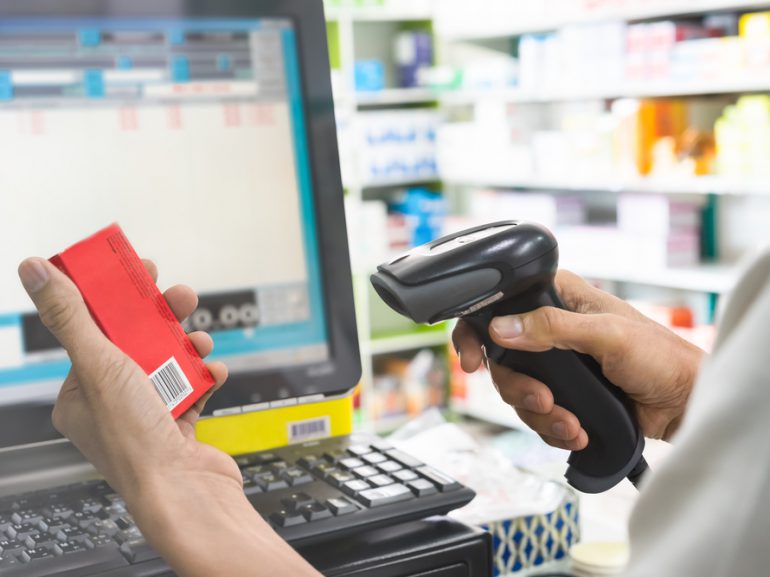Since 2016, undergraduate and postgraduate students from the Sydney Business School have collaborated with students from the Sydney School of Pharmacy, as part of a interdisciplinary project involving mapping the business processes of a community pharmacy. In 2016, a team of academics from the Business Information Systems (BIS) Discipline led by Corina Raduescu received Educational Innovation Project funding from the Business School to develop the foundations of an educational ecosystem for teaching the complexities associated with real-world information infrastructures.
This article was contributed by Corina Raduescu and Sarira El-Den.
Bringing the real world into the classroom
The first part of the project involved developing ten short videos capturing everyday processes that occur in a community pharmacy, from entering patient details in dispensing software to supplying appropriate medications. The shooting took place at the MediAdvice Pharmacy Hub in Glebe and involved the domain expert input of Dr Sarira El-Den, a registered pharmacist who was completing her PhD at the School of Pharmacy. Over the next two years, and following her appointment as a Lecturer in 2018, Sarira continued to collaborate with the Business School, to facilitate the integration of the videos into the curriculum of Business Process Management, and other BIS units at both the undergraduate and postgraduate level. We have been working together on developing teaching content, assessments, and in-class live interactions around the video cases.
The underlying problem these videos aimed to address was students’ difficulties in perceiving and understanding complex processes without direct access to real world examples. So, a decision was made to bring the real world into the classroom. Students were therefore exposed to various videos capturing instances of the dispensing process, in a similar fashion as observing the process live in-action. They were encouraged to reflect on their observations by documenting the process using assumptions on what they believed the process looks like.
As part of an assignment (download the assignment guide here), students were required to address their assumptions with research into the nature of each process they observed. However, given that they were Business Students, not pharmacists, they still had various questions, which could not be answered without real-life pharmacy experience. Hence, students were asked to develop a set of questions and enquiries for clarification. Naturally, Business students had many (over 600!) questions around a domain they had no familiarity with – “Why did the pharmacist ask questions in a certain order? Is the software connected to the internet? Why does the pharmacist enter a locked room for certain drugs? What is a generic brand? What is emergency supply? What if the drug is out of stock?”
To respond to these questions, Sarira attended two tutorials per semester and conducted Q&A sessions in class. In response to these questions, Sarira developed a repository of questions and answers that are now planned to be captured as a series of video interviews with a pharmacist. Through this questioning, students were directly exposed to the real world though both observations and interviews with domain experts. Immediately, it became apparent to Business students that a process that looked very simple was, in fact, extremely complex behind the scenes. Armed with this information, the BIS students developed a process model and researched a potential technological solution to the issues they observed in the real-life pharmacy setting.
Extending the task
The assessments have evolved over time to include other aspects of a pharmacist’s job that relate to the broader operational context and processes encountered in a community pharmacy (e.g., the claiming process involving the reimbursement for medications subsidized by the PBS). Specifically, in the undergraduate unit, we exposed students to the dispensing process that at first sight appears very simple; however, it encompasses complexity around processes, systems, control, risks, regulations, stakeholders, and their integration. For students to undertake a full analysis of this process, they need access to in-depth contextual information around the pharmacy environment that in turn, assists them in understanding the process, then conducting an analysis, and finally providing recommendations for improvement. The videos we created have shed light on the process and its contextual information, including pharmacy operating business models, the links between all processes that involve dispensing (e.g., electronic medical record access, Medicare claims, inventory management, etc.), as well as financial positions and technology associated investments.
In the postgraduate unit, students are exposed to the dispensing process videos but they take a management perspective to the processes, and therefore require a broader picture of the information infrastructures to assist them in understanding the impact of current e-health initiatives in a pharmacy context and how these initiatives are embedded within the pharmacy processes when analysing and recommending improvements. In addition, from a managerial perspective, students must become aware of other processes operating within a pharmacy context and their dependencies and links in order to make suitable and sustainable recommendations for improvement.
Broader impacts on student learning
The videos have also been used in lectures within the Sydney School of Pharmacy in 2018 in PHAR4812 (Integrated Dispensing) and in 2019 in PHAR3100 (Clinical Placements) to expose and teach pharmacy students about different aspects of their future practice, such as, dispensing, stock control, counselling, and communication to ensure the safe, legal and appropriate supply and use of medicines.
Building on from the initial videos to the in-depth teaching materials and assessments, we feel extremely satisfied they have succeeded in teaching and giving students an understanding of the complexity inherent in the real world. Informal evaluations of the learning outcomes in INFS2020 and INFS6015 highlighted positive responses from students towards the use of an integrated case study to teach a complex process and to build their soft and analytical skills:
- “Thinking in and outside the box considering all dimensions, it forced us to think as if we were actually working with real clients and their problems.”
- “Any process, even if it looks easy, may become complex as we drill down”
- “Business process management knowledge with real business process in real pharmacy as a perfect example during the whole study”
- “Understanding a complex process takes a lot more work than expected – the human element plays a huge role”
- “It gave us a holistic view of working in a business process management/change project”
Formal USS evaluations have also been in line with the positive verbal feedback, as evidenced by high USS scores for the postgraduate unit in 2018. It is worth noting that 94.4% of students responded strongly agree/agree to the following statement: “The initiative to use assessments based on video cases and live stakeholder engagement in class has had a positive impact on my learning experience.”
Students’ feedback proves the value of this interdisciplinary initiative in preparing them for how businesses operate in today’s ever-changing environment.





